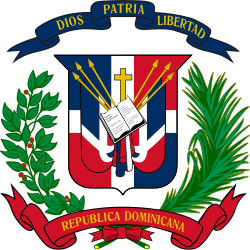Congress of the Dominican Republic
| Congreso Nacional de la República Dominicana | |
|---|---|
 | |
| Type | |
| Type | |
| Houses |
Senate Chamber of Deputies |
| Leadership | |
President of the Senate | |
President of the Chamber of Deputies | |
| Seats | 210, 32 senators and 178 deputies |
| Meeting place | |
| Palace of Congress | |
| Website | |
| http://www.congreso.gov.do | |
 |
| This article is part of a series on the politics and government of the Dominican Republic |
| Constitution |
|
Legislature |
| Political parties |
| Foreign relations |
The Congress of the Dominican Republic is the bicameral legislature of the government of the Dominican Republic, consisting of two houses, the Senate and the Chamber of Deputies. Both senators and deputies are chosen through direct election. There are no term limits for either chamber.
As provided by the Dominican Constitution, each of the 178 members of the Chamber of Deputies represents a district and serves a four-year term. Chamber seats are apportioned among the states by population. The 32 Senators serve staggered four-year terms. Each province has one senator, regardless of population.
The Constitution vests all legislative power in the Congress. The Chamber and Senate are equal partners in the legislative process (legislation cannot be enacted without the consent of both chambers); however, the Constitution grants each chamber some unique powers. The Senate is empowered to approve treaties and presidential appointments. Revenue-raising bills must originate in the Chamber of Deputies, which also has the sole power of impeachment, while the Senate has the sole power to try impeachment cases.
The Congress meets in the Palace of Congress in Santo Domingo, Dominican Republic.
The term Congress actually refers to a particular meeting of the national legislature, reckoned according to the terms of representatives. Congressional elections are held in even numbered years not divisible by four, even-numbered years divisible by four are reserved for presidential elections. Suffrage is universal and compulsory for all Dominican citizens aged over 18 or under that age if married.
History
The Congress of the Dominican Republic was founded after the drafting of the Constitution, on 6 November 1844. In the chapter 2 of this Constitution is mentioned how the Legislature would be divided into two legislative bodies called Tribunat (corresponding to the current House of Deputies) and Conservative Council (corresponding to the current Senate). Earlier, deputies and senators were elected by indirect and based on census vote and candidates could only be those with properties.
In 1854, the Constitution was amended to change the name of the Conservative Senate Council. Later, in December of the same year, a new revision to the Constitution was made to merge the two chambers in a Consultant Senate, being the first period in the history of the Dominican Republic in which the Legislature was governed by a unicameral Congress. The bicameral system was again replaced in November 1865 after the Restoration of the Republic, separating the Congress in a House of Representatives and House of Representatives.
Between 1866 and 1907, the Dominican Republic is disputed between bicameral and unicameral, eliminating the Senate in the constitutional amendment of 1866, restoring it in 1878, and returning it to eliminate in 1880. The Senate reappeared as house of Congress in the Constitution of 1908, from which the bicameral system remained constant. During the first US intervention, Congress was dissolved not before elected president Francisco Henriquez y Carvajal. After the restoration of national sovereignty, Congress was again restored, and in 1927 the election of legislators were allowed by direct vote.
With the rise of Rafael Leonidas Trujillo to power, the Congress became a cover for his political ambitions. In 1935, Trujillo was appointed by the Congress president for life, instituted on January 11 of each year as the Day of the Benefactor, and renamed the capital city Ciudad Trujillo. In 1941, Congress recognized the civil rights of women, allowing women to vote in the country.
After Trujillo's death, and after deposition of the constitutional government of Juan Bosch in 1963, Congress was dissolved by the Triumvirate. On 25 April 1965 a military group seeking to restore the Constitution of 1963 and replace the president Bosch entered the National Palace and made capitulate to Triumvirate, after which the newly restored Congress was sworn in as provisional president to the President of the Chamber of Deputies Jose Rafael Molina Ureña. However, President Urena had to resign two days later and applied for asylum. At this, the Congress appointed provisional president Francisco Alberto Caamaño Deñó, who took office on May 4 in front of a crowd at Independence Park.
After the second US intervention, and after the new constitutional government elected in 1966, under the presidency of Joaquin Balaguer, Congress made an, the longest constitutional reform of constitutional reforms. This Constitution was amended in 1994 to prohibit presidential re-election and separate congressional and presidential elections (which had been held together since the reform of 1927) with 2 years apart.
Congress passed a constitutional amendment in May 2002, to restore limited to 2 consecutive reelection. During the election of President of the Chamber of Deputies on 16 August 2003, there was a shooting inside the room that legislative chamber.
Later in the constitutional reform of 2010, Congress passed non-consecutive presidential reelection, and rejoined the congressional and presidential elections, which are exceptionally extended the term of office of elected legislators in 2010 from 4 to 6 years until 2016.
Latest election
Template:Dominican Republic legislative election, 2010
See also
- Politics of the Dominican Republic
- List of political parties in the Dominican Republic
- List of legislatures by country
.svg.png)